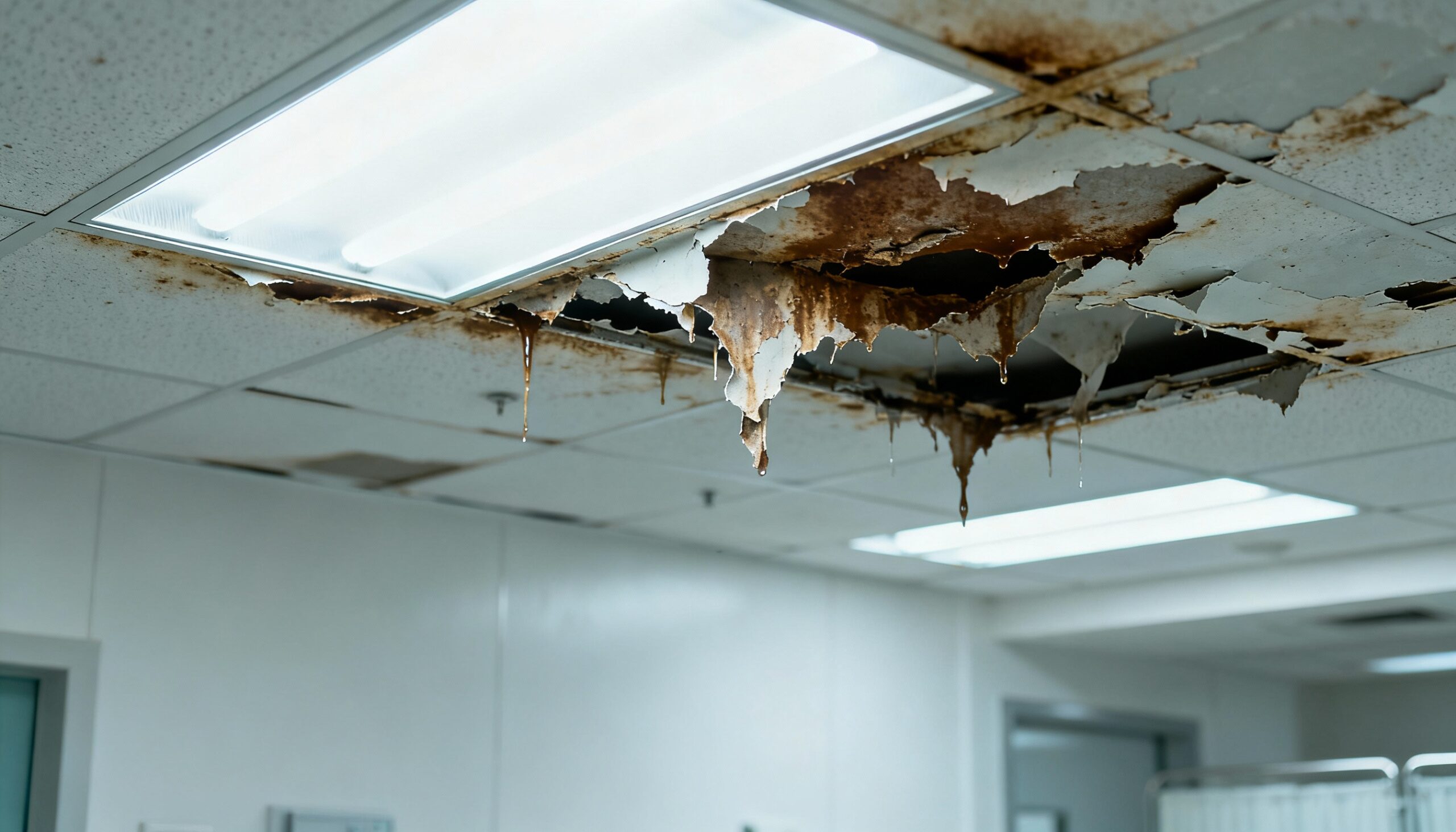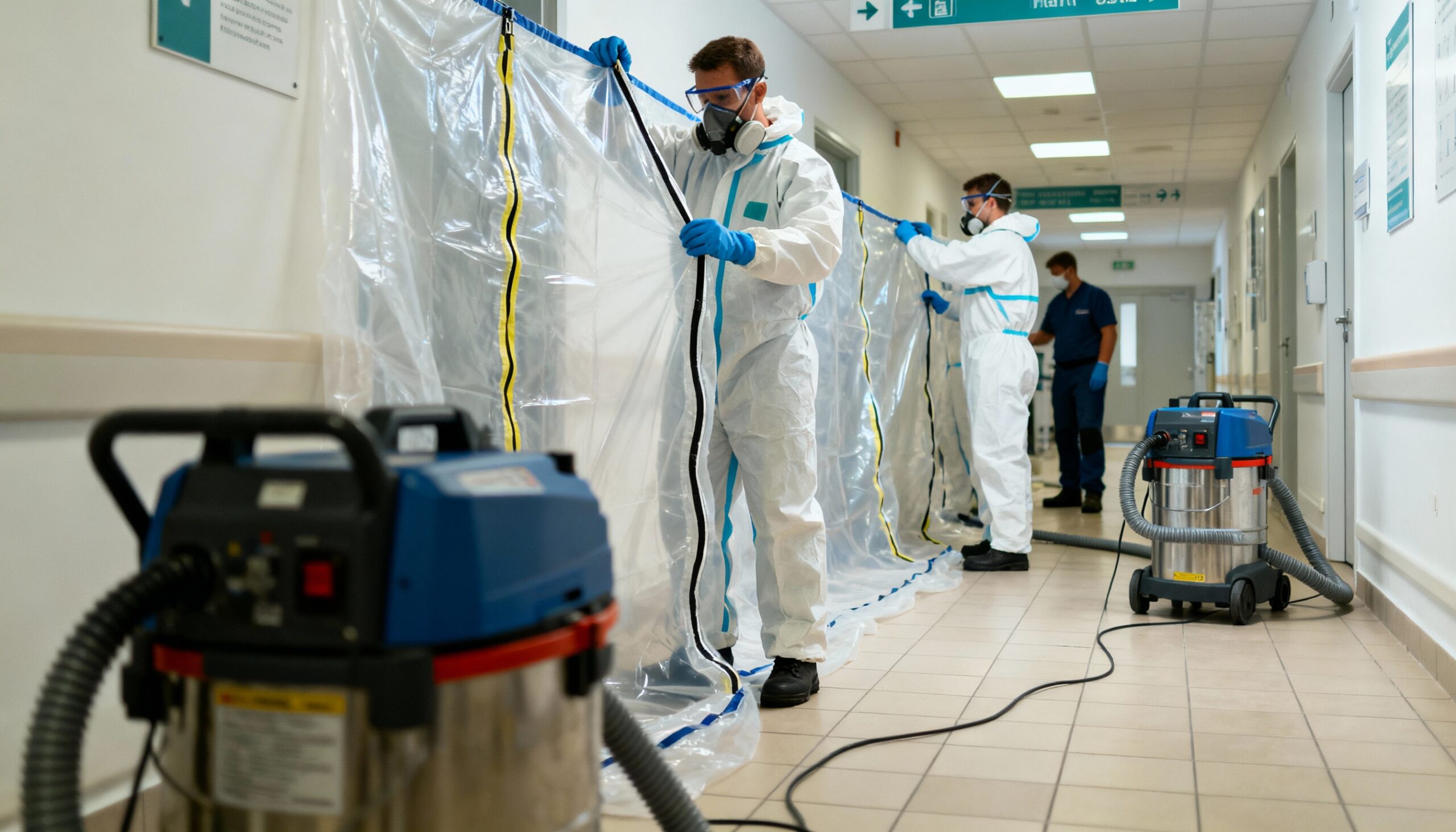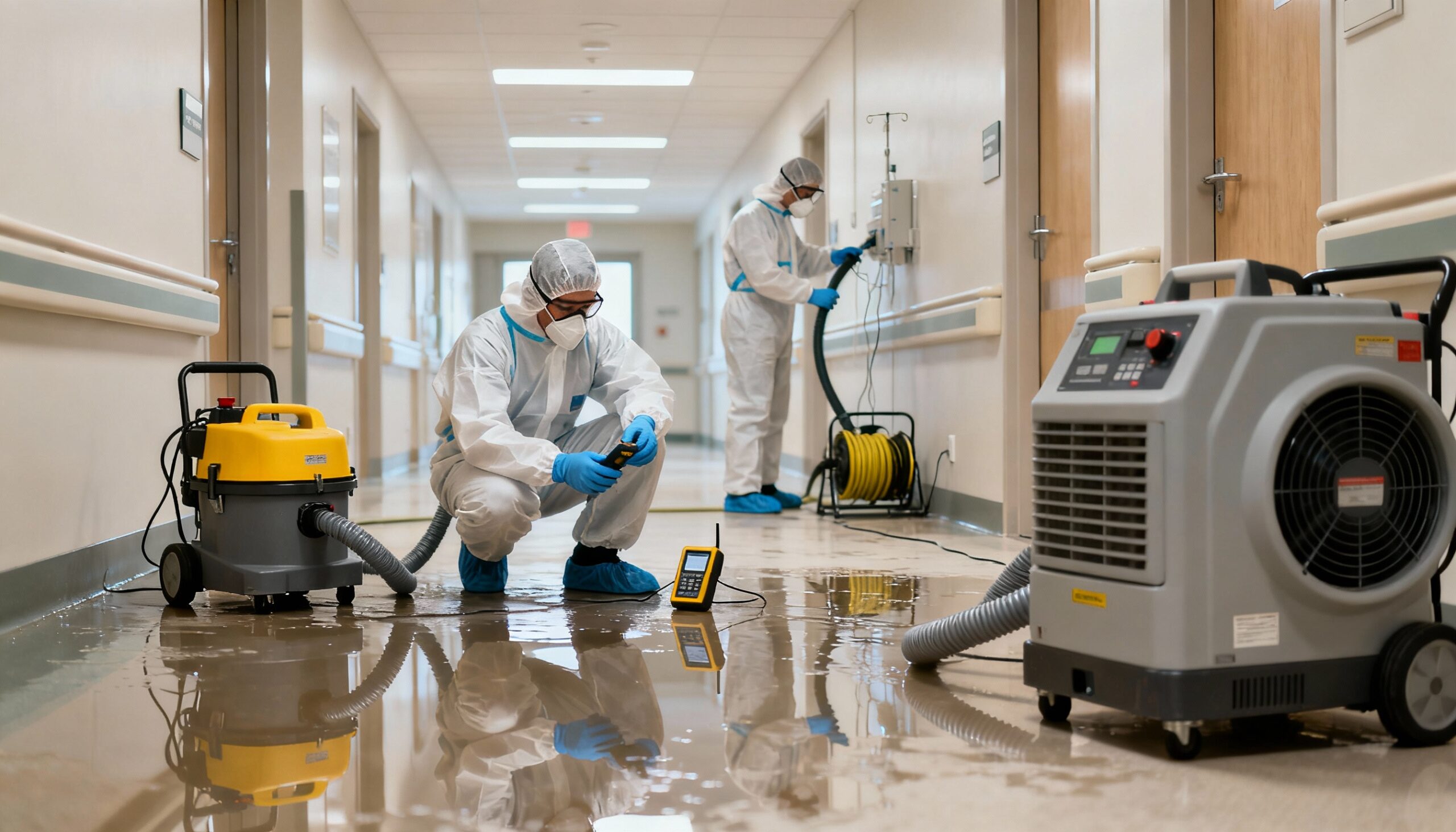What Makes Medical Facility Water Damage Different?
Hospital water damage presents challenges that don’t exist in typical commercial restoration scenarios. Medical facilities operate under strict regulatory oversight from organizations like The Joint Commission, CMS, and state health departments. These regulations govern everything from air quality to surface sanitation, creating complex restoration requirements.
Healthcare restoration must address infection control as a primary concern. Water intrusion in medical facilities can introduce or spread pathogens, compromise sterile environments, and contaminate critical areas. The presence of immunocompromised patients means even minor water events require intensive mitigation protocols.
Medical facilities also house specialized equipment worth millions of dollars. Diagnostic imaging machines, laboratory equipment, and life-support systems are highly sensitive to moisture and require immediate protection. Medical building flooding can render entire departments unusable if not addressed with proper expertise.
Common Sources of Medical Facility Water Damage
Understanding how water damage occurs in healthcare settings helps facilities develop targeted prevention strategies. Medical facilities face unique vulnerabilities due to their complex infrastructure and continuous operation demands.

Infrastructure Failures
Aging pipe systems in older hospitals frequently fail without warning. Medical facilities operate 24/7 with constant water demand, accelerating wear on plumbing infrastructure. Pipe bursts in ceiling spaces or between floors can affect multiple departments simultaneously, requiring immediate commercial water cleanup and extraction to prevent widespread damage.
HVAC systems in healthcare facilities are particularly complex, with extensive condensate drainage systems. Blocked drains or failed collection pans regularly cause water accumulation in ceiling spaces. These systems require specialized maintenance that general building engineers may overlook.
Equipment-Related Water Events
Medical sterilization equipment, including autoclaves and washers, processes thousands of cycles annually. Equipment failures can release large volumes of hot water into adjacent spaces. Dental offices face similar risks from waterline failures in treatment rooms. When moisture persists, professional commercial mold removal services become essential to prevent microbial growth in clinical environments.
Dialysis centers and imaging departments use substantial water volumes for equipment cooling and processing. Supply line failures in these areas can quickly impact sensitive clinical spaces. Laboratory facilities face additional risks from specialized water purification systems.
External Water Intrusion
Roof failures pose significant risks to medical facilities due to their typically large footprints and complex mechanical systems. Flat or low-slope roofs common in hospital design are particularly vulnerable during heavy rainfall. Flash flooding can overwhelm ground-level entries, affecting emergency departments and loading areas.
Regulatory Compliance in Healthcare Restoration
Medical facility water damage response must align with multiple regulatory frameworks simultaneously. Restoration contractors must understand these requirements to avoid violations that could jeopardize facility licensure or accreditation.
| Regulatory Body | Primary Focus | Key Requirements | Impact on Restoration |
|---|---|---|---|
| The Joint Commission | Patient Safety | Environment of Care standards | Documented protocols, staff training |
| CMS | Medicare/Medicaid Compliance | Conditions of Participation | Life Safety Code adherence |
| OSHA | Worker Safety | Hazard communication, PPE | Worker protection protocols |
| EPA | Environmental Protection | Medical waste handling | Contaminated material disposal |
Healthcare restoration contractors must maintain current certifications and training specific to medical environments. Teams working in active medical facilities need clearance protocols, including background checks and health screenings. Documentation requirements exceed standard commercial projects, with detailed logs required for all activities in patient care areas.
Critical Infection Control Protocols
Infection control drives every decision in medical facility water damage restoration. Water intrusion compromises the carefully controlled environments that protect vulnerable patients. Restoration activities themselves can introduce additional risks if not properly managed. Professional infection control services ensure compliance with healthcare standards throughout the restoration process.

Containment and Isolation
Hospital water damage restoration requires physical barriers that exceed standard construction containment. Negative air pressure systems prevent airborne contaminants from spreading to adjacent clinical spaces. HEPA filtration removes particles that could threaten immunocompromised patients.
Containment barriers must be seamless and regularly inspected. Even small gaps can allow moisture migration or airborne particle transmission. Access points require anteroom staging areas where workers don and remove protective equipment.
Surface Disinfection Requirements
All surfaces in affected areas require EPA-registered healthcare-grade disinfectants. Standard antimicrobial treatments used in residential or commercial settings don’t meet medical facility standards. Disinfection protocols must address specific pathogens relevant to healthcare environments.
Porous materials in medical areas often require removal rather than restoration. Carpet, ceiling tiles, and wall coverings in clinical spaces cannot be reliably disinfected after water exposure. In cases involving sewage or contaminated water, specialized biohazard cleanup services ensure safe removal and disposal. Healthcare restoration prioritizes replacement with materials that support rigorous cleaning protocols.
💡 Pro Tip: Medical facilities should maintain emergency response plans that identify which areas can tolerate standard restoration and which require enhanced protocols. This pre-planning accelerates response when incidents occur.
Protecting Critical Medical Equipment
Medical equipment represents massive investments that require immediate protection during water events. Many devices are irreplaceable in the short term, making emergency response critical to maintaining care capacity.
Imaging equipment like MRI machines and CT scanners are extremely moisture-sensitive. Even humidity increases can damage sensitive electronics worth millions. These systems require climate-controlled environments maintained throughout restoration.
Laboratory analyzers and testing equipment face similar vulnerabilities. Medical building flooding in lab areas can contaminate samples and compromise testing capabilities. Restoration teams must coordinate with biomedical engineering staff to assess equipment safety.
Pharmacy areas demand special attention due to medication storage requirements. Water damage can compromise medication integrity, requiring extensive inventory assessment. Temperature and humidity monitoring continues throughout restoration to protect pharmaceutical supplies.
Maintaining Operations During Healthcare Restoration
Unlike other commercial properties, medical facilities cannot simply close for restoration. Patient care continues even as restoration teams work to mitigate damage and restore affected areas. This requires 24-hour emergency services that can respond immediately and work around clinical schedules.
Phased Restoration Approaches
Hospital water damage restoration typically occurs in phases that minimize disruption to clinical operations. Critical patient care areas receive priority attention, with restoration scheduled around clinical schedules when possible. Non-clinical spaces may be addressed during off-hours to reduce noise and disruption.
Temporary relocation of departments or services may be necessary for major incidents. Facility planners work with restoration teams to identify suitable swing spaces that meet clinical requirements. These temporary arrangements must satisfy the same regulatory standards as permanent facilities.
Communication Protocols
Healthcare restoration demands exceptional coordination between multiple stakeholders. Clinical staff need regular updates on restoration progress and any potential disruptions. Patients and visitors require clear communication about facility changes and alternative access routes.
Emergency response teams, security personnel, and facility management must maintain constant communication channels. Medical facility water damage incidents can evolve quickly, requiring real-time coordination to protect patient safety.
⚠️ Important: Never attempt DIY restoration in medical facility water damage situations. The infection control requirements, regulatory compliance, and life-safety considerations demand specialized professional expertise.
Specialized Drying and Dehumidification
Standard restoration drying techniques require modification in healthcare settings. Air movers and dehumidifiers must be positioned to avoid disrupting critical medical equipment or interfering with HVAC systems that maintain required environmental conditions.
Temperature and humidity targets in medical areas are often stricter than general commercial spaces. Operating rooms, laboratories, and pharmaceutical storage areas have specific environmental requirements that must be maintained during drying operations. Restoration equipment must be selected and positioned to support rather than compromise these requirements.
Noise considerations are paramount in patient care areas. Traditional high-velocity air movers may be unsuitable near patient rooms, intensive care units, or recovery areas. Healthcare restoration contractors utilize lower-noise equipment and schedule loud activities during times that minimize patient impact.
Documentation and Compliance Reporting
Medical building flooding events require extensive documentation beyond standard restoration projects. Regulatory bodies may review incident reports, mitigation activities, and restoration procedures. This documentation protects facilities during audits and demonstrates compliance with applicable standards.
Photographic documentation must capture conditions before, during, and after restoration. Moisture readings, temperature logs, and humidity measurements create objective records of environmental conditions. These records may be required for insurance claims, regulatory reporting, or litigation defense.
Facilities must document any temporary operational changes implemented during restoration. This includes patient relocations, service suspensions, or modified clinical protocols. These records demonstrate the facility’s commitment to maintaining care quality despite emergency conditions.
| Documentation Type | Purpose | Retention Period | Primary Audience |
|---|---|---|---|
| Incident Reports | Event documentation | 7-10 years | Facility management, insurers |
| Moisture Readings | Drying verification | Duration of restoration | Restoration contractors |
| Infection Control Logs | Protocol compliance | Per facility policy | Infection control, regulators |
| Equipment Assessments | Loss documentation | Per insurance requirements | Biomedical engineering, insurers |
Prevention Strategies for Medical Facilities
Proactive measures significantly reduce medical facility water damage risk. Regular maintenance programs identify potential failures before they cause extensive damage. Facility management teams should implement comprehensive water management strategies.
Automated leak detection systems provide early warning of plumbing failures. These systems can shut off water supply to affected areas and alert facility management immediately. Smart building technology enables remote monitoring of critical systems even during off-hours.
Regular infrastructure assessments identify aging components that require replacement. Plumbing systems, roof membranes, and HVAC condensate systems have predictable lifespans. Planned replacement prevents emergency failures that disrupt patient care.
Staff training ensures rapid response to water events. Healthcare workers should know how to shut off local water supplies and who to contact for emergency response. Regular drills prepare teams to respond effectively when incidents occur.
🏠 Home Tip: Medical office buildings and outpatient facilities should develop emergency response plans that include after-hours contact procedures. Water damage doesn’t respect business hours, and rapid response minimizes damage severity.
Selecting Healthcare Restoration Specialists
Not all restoration contractors possess the expertise required for medical facility water damage. Healthcare restoration demands specialized training, certifications, and experience that exceed general commercial restoration capabilities. Contractors with proven healthcare industry expertise understand the unique regulatory and operational requirements of medical facilities.
Qualified healthcare restoration contractors maintain current training in infection control protocols and medical facility regulations. They carry appropriate insurance coverage including professional liability policies that address healthcare-specific risks. References from other medical facilities provide valuable insights into contractor capabilities.
Pre-qualifying restoration contractors before emergencies occur streamlines response when incidents happen. Facilities can verify credentials, review protocols, and establish communication procedures in advance. This preparation enables faster mobilization and more effective coordination during actual events.
Frequently Asked Questions
How quickly must medical facility water damage be addressed?
Medical facility water damage requires immediate response within the first hour when possible. The 24-48 hour window critical in residential settings becomes even more compressed in healthcare environments due to infection control concerns and operational continuity requirements. Delays increase contamination risks and prolong service disruptions that impact patient care.
Can medical facilities continue operating during water damage restoration?
Yes, most medical facilities maintain operations during healthcare restoration through careful planning and phased approaches. Restoration teams work around clinical schedules, and patients may be temporarily relocated within the facility. Complete shutdowns are rare and typically only occur for catastrophic events affecting life-safety systems. Professional restoration contractors experienced in medical environments can minimize disruption while maintaining patient safety.
What makes hospital water damage restoration more expensive than commercial restoration?
Healthcare restoration costs reflect specialized requirements including infection control protocols, enhanced containment systems, and regulatory compliance documentation. Contractors need additional certifications and insurance coverage. Work often occurs during off-hours to minimize clinical disruption, requiring premium labor rates. Medical-grade disinfection, HEPA filtration, and materials that meet healthcare standards also increase project investment compared to standard commercial restoration.
What credentials should healthcare restoration contractors possess?
Qualified healthcare restoration contractors should have specific training in medical facility restoration, infection control protocols, and regulatory compliance. They must carry appropriate insurance including professional liability coverage. Look for contractors with documented experience in hospital water damage projects and positive references from other medical facilities. OSHA compliance and worker health screening programs are essential for teams working in active healthcare environments.
How can medical facilities prevent water damage?
Prevention strategies include regular infrastructure inspections, automated leak detection systems, and planned replacement of aging components. Staff training ensures rapid response to water events. Maintaining detailed emergency response plans with pre-qualified restoration contractors accelerates response when incidents occur. Regular testing of emergency shutoff systems and clear signage helps staff respond effectively during water emergencies.
Does insurance cover medical facility water damage restoration?
Medical facility property insurance typically covers water damage restoration, though coverage varies by policy. Sudden and accidental water damage like pipe bursts is usually covered, while gradual leaks or maintenance-related issues may have limited coverage. Business interruption coverage may help offset revenue loss during restoration. Medical facilities should review policies with insurance professionals to understand specific coverage limits and exclusions for water damage events.

